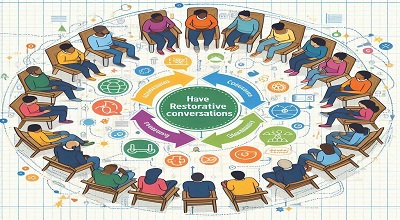Blueprint for Restorative Conversations
Restorative conversations are a critical part of the restorative justice process, which aims to address harm, repair relationships, and promote healing. These conversations can be challenging but are essential for achieving resolution and reconciliation. Here’s a blueprint for conducting restorative conversations, taking into account the latest principles and practices:
Preparation:
- Identify Stakeholders: Determine who should be involved in the conversation. This may include the harmed party, the responsible party, supporters, and facilitators.
- Select Facilitators: Choose experienced and trained facilitators who can guide the conversation impartially and effectively.
- Establish Ground Rules: Establish ground rules for the conversation, emphasizing respect, active listening, and confidentiality.
- Arrange a Safe Space: Find a neutral and safe environment for the conversation, ensuring all participants feel comfortable.
- Pre-Conversation Meetings: Hold separate meetings with the harmed and responsible parties to prepare them emotionally and mentally.
Introduction:
- Opening Statement: Begin with a brief opening statement to explain the purpose of the restorative conversation, emphasizing the goals of understanding, accountability, and healing.
- Voluntary Participation: Ensure that all participants are there voluntarily and understand the process.
- c. Confidentiality Reminder: Reiterate the importance of maintaining confidentiality to create a safe space for honest communication.
- Storytelling and Empathy:
- Harm Party’s Perspective: Allow the harmed party to share their experience, feelings, and the impact of the harm. Encourage them to use “I” statements to express their emotions.
- Responsible Party’s Perspective: Give the responsible party an opportunity to share their perspective, intentions, and feelings without interruption.
- Active Listening: Encourage active listening from both parties, with the facilitators ensuring that each person feels heard and understood.
- Empathy Building: Facilitate empathy-building exercises, such as paraphrasing or asking open-ended questions to help participants understand each other’s viewpoints.
Accountability and Responsibility:
- Acceptance of Responsibility: Ask the responsible party if they acknowledge their actions and accept responsibility for the harm caused.
- Understanding Impact: Ensure the responsible party understands the full impact of their actions on the harmed party and others involved.
- Apology: If appropriate, guide the responsible party in offering a sincere apology to the harmed party.
Reparation and Agreement:
- Reparation Ideas: Encourage the participants to brainstorm potential actions or reparations that can help repair the harm and rebuild trust.
- Agreement: Facilitate negotiation and agreement on specific actions the responsible party will take to make amends and prevent future harm.
Closure and Follow-up:
- Closure: Conclude the conversation by summarizing the agreed-upon actions, expressing hope for healing, and thanking the participants for their commitment to the process.
- Follow-up Plan: Develop a plan for follow-up meetings or check-ins to monitor progress, provide support, and ensure that agreed-upon actions are being carried out.
- Documentation: Document the conversation, agreements, and any future steps. Ensure that all parties receive a copy of the documentation.
Support and Resources:
- a. Provide Resources: Offer information about support services, counseling, or community resources that may assist the parties in their healing journey.
Closure:
- Evaluation: Conduct an evaluation of the restorative conversation process to gather feedback and make improvements for future cases.
Final Words
Remember that restorative conversations require patience, empathy, and a commitment to the principles of restorative justice. The process may vary depending on the specific context and the needs of the individuals involved, but this blueprint provides a general framework for conducting effective restorative conversations.
